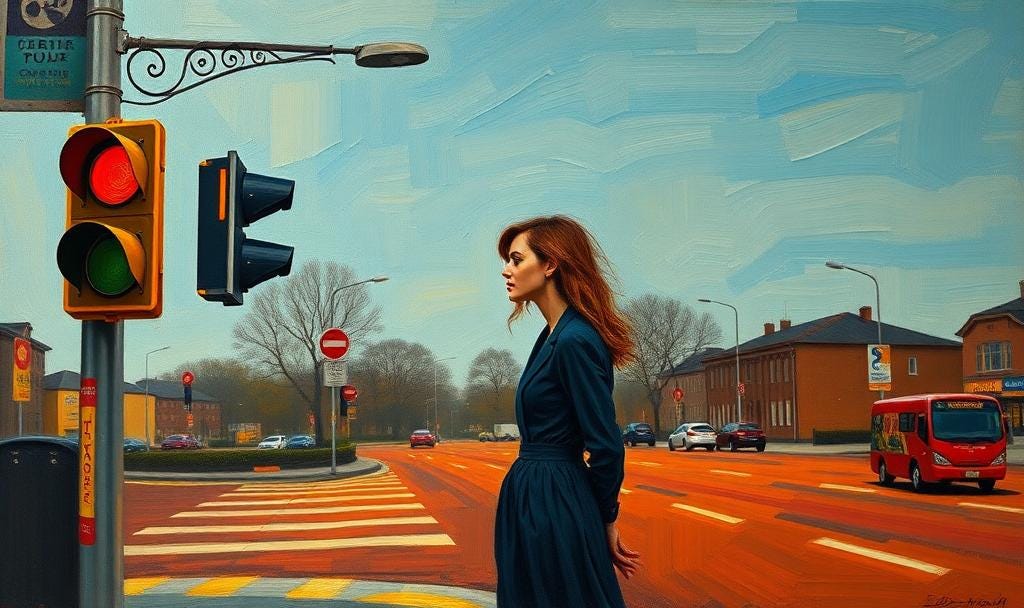My shopping bag was being tugged at by the security guard, the crackle of the paper tear rippling throughout the silent store. No matter where I looked, he was eyeline with me, like a nightmare you can’t blink away. Their hot, angry breath swelled around my nose. ‘I didn’t do it,’ I exclaimed.
The words came out quick and fast, the wobble in my throat betraying the collected exterior I’d tried to portray at my accusation of shoplifting. Everyone around me shuffled further into the store, pretending to be preoccupied with butter yellow midi skirts. Or they stood and stared, mouths open, their minds casting me guilty.
Except, none of that actually happened. At least, not to me. It happened to a woman I watched one Saturday afternoon in a hot and heaving shopping centre. Yet, as the security guard continually blocked her side stepping away from him, my body fell into an anxiety attack. I struggled to peel my tongue from the roof of my mouth, my heartbeat made its way to my ears, my face flushed red.
There’s a lot of content doing the rounds on social media at the minute about how annoying it is that our bodies can’t tell the difference between being chased by a saber tooth tiger and having a morning coffee (it’s true: we only have one stress response), but I couldn’t even tell the difference between what was happening to me and what was happening around me.
It’s not that I had an out-of-body experience or disassociated from reality – my brain knew I was watching someone else. I wish I could have helped her (this isn’t commentary on the morals of stealing, in this economy). Instead, I felt the referral of her panic, my body freaking out in belief that I was the one being reprimanded.
There are plenty of psychological theories as to why that happens – call it ‘emotional contagion theory’ or ‘mirror neuron systems’, both of which suggest that emotions can spread between people like a virus. But my body making me the victim of a potential shoplifting takedown that I had nothing to do with was a classic example of what my friend Anna (author of
) and I refer to as ‘living in the red’.It’s a theory we’ve clung to since she wrote about it in a magazine about five years ago. The idea goes that our bodies run like traffic lights: when we’re in the green, things feel light and breezy; we’re able to get on with life. In amber, things may feel slightly slower, but are ultimately achievable. Hit red, and your body and mind become unable to cope with what you’re asking of them.
The goal is to live most of our lives in the green. That way, when one of the inevitable stressful moments happens, you fall into amber: a more alert state, but one that’s manageable if it’s experienced in the short term. The problem, as Anna wrote in her piece, is that so many of us simply exist in amber. We move through the world in fuzzy states of overwhelm – a little too tired, a little too frazzled, a little too worried. From there, we can only fall into red.
My life had been amber for a while. I’d even go so far as to say it was more like a fiery, warm orange – months of unthinkable chaos pushing my brain too close to red for comfort. Anna knew this. We discussed our personal colour charts often, normally as she stirred softened tomatoes through glossy pasta or ran her finger under the foil of the 70% dark chocolate I love.
Then there was the final straw, the event, that sent me into red. It spiralled so far that it even stopped being the bright scarlet of a warning sign: it became a dark, lived-in crimson, like a red wine stain that you’ll never get rid of.
Which is to say: stress had nowhere to go. And so I would find myself breathless at someone brushing past me, my body assuming it was an attack. I didn’t have a full night’s sleep in weeks, my brain feeling the need to stay on high alert even while in bed. I belly cried whenever someone asked me to do something for them, unable to add the seemingly mountainous task that was sending an email to the Everest hike my mind was already on. Then, I lost my reality in a high street clothing shop.
Getting out of it required a plan
, Anna and I frequently prescribe to each other: special measures. In special measures, you do whatever you can to get through the day. You do not attempt to thrive. You don’t deprive, push or challenge yourself for the sake of betterment. You do not berate yourself for lacking creativity or productivity. You treat yourself, regularly, and create a cosy world in which nothing else can harm you. If I could paint a picture of special measures, it would be someone lying under a blanket, reading a book, eating a hot bowl of soup.In a directly contradictory-sounding statement, I also ran a marathon – but it wasn’t done from a place of self-improvement (I couldn’t have cared less about my split times), more from the fact that I had to have some way of getting myself out of bed on the weekends, and the anxiety of not being able to complete the 42.2km I’d already signed up for was enough motivation.
I also waited: it took two months before I could socialise (I have since been told that I seemed ‘really not ok’ at that first event that took all my strength to go to). Three months before I could properly focus on a conversation. Four until I felt my body and mind were capable of things. Five until I fell on the floor weeping with laughter, surrounded by the friends who had supported me despite half a year of my glassy eyes and tears.
It’s a work in progress, but I’d say I’m living in amber now, with days of green sprouting through like the first blades of grass growing from a freshly sewn field. Staying out of the red – and in my own body – is my only goal for the rest of 2025.




